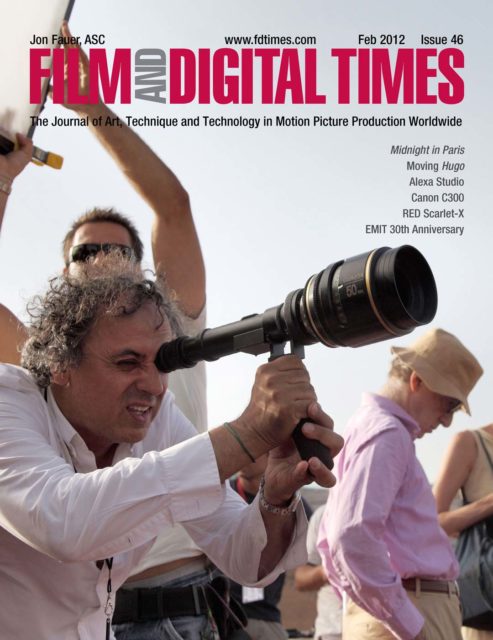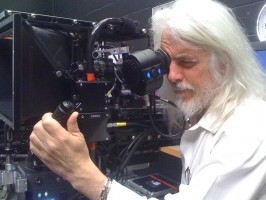Film and Digital Times February 2012 Issue 46 is now ready for subscribers to download. The print editions are at the printer and will be mailed from LA the week of January 30th.
The AFC Micro Salon French edition–in French–is also online now, and free to download. Courtesy of our sponsors in France and the kind cooperation of the AFC Micro Salon, printed copies of the French Edition will be distributed at the event on February 10-11 in Paris.
On the cover: Darius Khondji, ASC, AFC in Rome on Woody Allen’s Nero Fiddled, to be released in 2012. Photo by Philippe Antonello, courtesy of Massimo Proietti, General Manager of Panalight, the rental house in Rome that equipped the production, with permission of Woody Allen. Darius is lining up a shot with a Cooke 5/i 50 mm prime on a PL finder.
“Paris is always a good idea,” (Audrey Hepburn in Sabrina). Paris certainly was a great idea for our two favorite films of the year: Midnight in Paris and Hugo. Midnight in Paris was filmed in Paris on film. Hugo takes place in Paris, was shot partly in Paris, mostly at Pinewood and Shepperton, and done in digital 3D.
In Midnight in Paris, Gil asks Hemingway to read his novel and give an opinion. Hemingway answers, “If it’s bad, I’ll hate it. If it’s good, then I’ll be envious and hate it even more. You don’t want the opinion of another writer.”
We happen to have the opinions of more than a dozen writers in this edition. Woody Allen and Darius Khondji talk about the style of Midnight in Paris. Darius discusses look, light, lenses, paintings, and photographs.
For Hugo, we have: Bob Richardson, ASC (Cinematographer), Rob Legato (Second Unit Director and Visual Effects Supervisor), Chris Centrella (Key Grip) , Larry McConkey (Steadicam driver and operator), Demetri Portelli (Stereographer), and Gregor Tavenner (First Assistant), with special appearances by Howard Preston (Preston Cinema Systems), Jean-Marie Lavalou (Loumasystems), and Laurent Mannoni (French Cinematheque). This section of FDTimes happens to be longer because I knew more crew on Hugo than Midnight. It’s kind of a Rashomon approach. Although Rashomon had four characters telling four divergent stories, our dissection of Hugo has eight primary sorcerers telling the same story.
For example, Bob Richardson talks about the beautiful shot in the National Film Library, with the shafts of light streaming through the windows:
“Weren’t they stunning? It was natural light. It’s a real location, the Bibliothèque Sainte-Geneviève. We were very fortunate that we had these shafts. We lit outside each window in advance, and then the real sun came streaming in. The shot was, for both Marty and myself, an extraordinarily remarkable moment. I set up two dollies simultaneously, knowing the speed at which the sun was going to come, so we’d get a series of shots when the sun was there. And I set one closer for the medium shot and one further back for a wider shot. And then, on top of that, we had the crane on the left hand side move one, two, three, as rapidly as possible, to keep the sun in its proper place to match.
“It was fascinating that, as I was setting the shot up, I looked and I saw what you just described. And it was, for me, almost a spiritual event. Because the light became solid. And it made me think of where we sit in this world. When we think that something is not real and may not exist or matter, it is in fact filled with solid elements, regardless of size.
“Marty and I noticed that the beams of light were like solid beams. They almost looked like they were made of wood. You felt the solidity of it, and you knew that you were walking through it, seeing people walk through it. Yet you knew it wasn’t solid. There’s a remarkable transformation that takes place in your brain. That, for me, was one of the major moments of the 3D, in terms of something I hadn’t seen to that point.”
There are many firsts and a lot of Cooke in this Book. Midnight in Paris and Hugo were the first major motion pictures shot with Cooke 5/i lenses. Hugo was the first feature to use all three sets of Cookes: Bob Richardson used 5/i, S4/i, and Panchro/i sets. Of course, since Hugo was a 3D production (the first to use ARRI Alexa cameras), each set of lenses was multiplied by 2 or more (since there were multiple camera setups). On Midnight in Paris, Darius Khondji used Cooke 5/i, S4/i, and Speed Panchro Series II and III lenses.
Darius explained, “We found the Cooke Speed Panchro Series II and III lenses in Paris, gathering dust, sitting on the shelves of the rental house. Few people use them. We had some of them redone, rehoused, had them worked on, cleaned and everything. They were beautiful. I used to use these lenses when I started as a cinematographer in France.
“For the look of the Twenties, we looked at paintings of George Bellows that I love from America in the 1920s: Ringside Seats, Dempsey and Firpo, and images from that period. They are beautiful. We looked at a lot of images of Paris in the Twenties: still pictures and also moving pictures that showed us the life of the time, the Roaring Twenties, that Woody wanted for his movie. We also researched what the light looked like at the time. I was trying to put myself back into that feeling, that state of mind.”
I hope you enjoy our February Issue 46.









